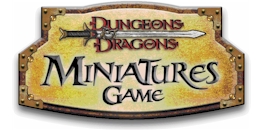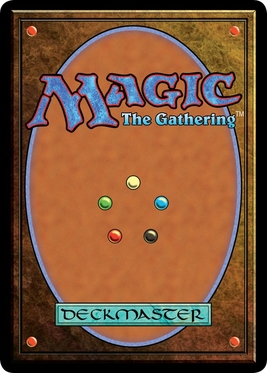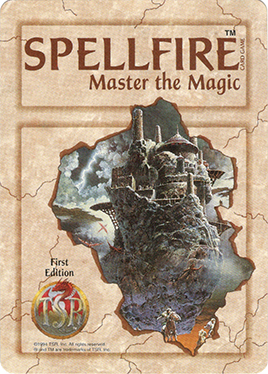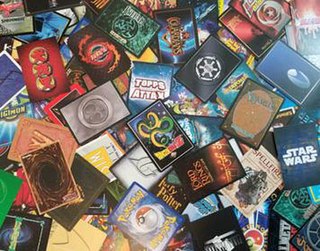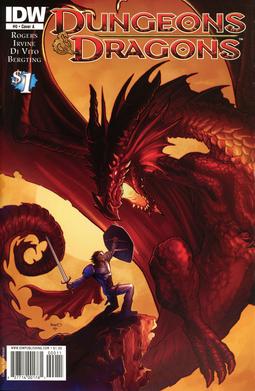History
The Dungeons & Dragons Miniatures Game, commonly referred to as DDM, served as Wizards of the Coast's official line of miniature figures for the Dungeons & Dragons game beginning in 2003, following the cancellation of the previous Dungeons & Dragons-based miniatures game, Chainmail, in August 2002. [1] The first set, Harbinger, was released on September 26, 2003. This set was available in both Starter Sets, containing 16 random miniatures, a 20-sided die, a rulebook and maps and terrain to play the game on, as well as Booster Packs with 8 random miniatures. Each miniature also came with a card that detailed the statistics of the figure for the miniatures game on one side, and the statistics for use in the role-playing game on the opposite side.
Following that first release, 20 additional expansion sets were released. Five of these sets (Giants of Legend, War of the Dragon Queen, Against the Giants, Legendary Evils, and Lords of Madness) contain figures standing on 3-inch-diameter (76 mm) bases, larger than the 2 inch bases of the largest figures in normal sets. This size is designated “Huge” in the nomenclature of Dungeons & Dragons, and the boosters containing these larger figures are known as “huge packs.” [1]
All figures are one of three rarities, indicated by a marking on the bottom of the miniature:
-
 "common"
"common" -
 "uncommon"
"uncommon" -
 "rare".
"rare".
From Harbinger to the Demonweb expansion, all standard-sized booster packs contained 4 commons, 3 uncommons and 1 rare. The Starter Set miniatures for Harbinger, Aberrations and War Drums included 1 rare, 5 uncommon and 10 common miniatures. Dangerous Delves and Savage Encounters each contained 2 commons, 1 uncommon, 1 non-random visible uncommon, and 1 rare. The four Huge sets listed above had different distributions of figures. Giants of Legend boosters contained 4 commons, 3 uncommons, 1 rare, and 1 huge, either rare or uncommon, while War of the Dragon Queen and Against the Giants each contained 3 commons, 3 uncommons, 1 rare, and 1 rare or uncommon huge. Legendary Evils boosters had 2 commons, 1 medium-sized rare, 1 large-sized rare, and 1 visible huge figure. The summer 2010 set Lords of Madness was the first and only set to contain very rares, a rarity previously used in Wizards of the Coast's Star Wars Miniatures game.
The game has gone through a number of major revisions since its inception. In early 2008 the game was changed significantly to maintain continuity with the Dungeons & Dragons fourth edition rules. This set of rules is known unofficially as D&D Miniatures 2.0. The first set released under this revision was Dungeons of Dread in April 2008. Additionally, over the course of the next year, all existing miniatures received updated stats so they would be playable in the new game. [2]
Less than a year later, in October 2008, Wizards of the Coast announced that the way miniatures would be packaged was changing. The miniatures would be sold in partially random monster packs, with one visible figure, under the Monster Manual name, and a new line of non-random minis called Player's Handbook Heroes featuring player character (PC) races. [3] [4] Shortly after that, another announcement was posted, clarifying these new changes. Following the release of the Demonweb expansion, the Dungeons & Dragons Miniatures skirmish game would no longer be supported by Wizards of the Coast. Skirmish statistics would no longer be included with the figures, and no further tournaments would be officially sanctioned. Instead, the miniatures line would be marketed solely to RPG users. [4] [5]
Since November, 2008, a group called the DDM Guild, founded and run by members of the fan community, has been granted the exclusive and worldwide right to continue to support and develop the D&D Minis skirmish game. Wizards of the Coast continues to provide DCI support as well as proprietary information on future set lists to the DDM Guild. [6]
Changes were announced at D&D Experience 2010, when it was revealed that the miniatures line would once again revert to entirely random packaging, with both PC and monster minis combined in one set. [7]
On January 12, 2011, Wizards of the Coast announced the immediate end of the Dungeons & Dragons Miniatures line. [8]
D&D Miniatures was consistently one of the top collectible games in hobby channel sales, with recent rankings from the industry magazine ICv2 placing the game as the 3rd best selling collectible game. [9] In 2010, the Dungeons & Dragons Miniatures line won the ENnies Award for Best Miniatures Product. [10]
Gameplay
Unlike Dungeons & Dragons, which like most role-playing games has players playing the part of a single character, the Dungeons & Dragons Miniatures Game is a miniatures wargame in which two opponents pit armies of creatures against each other. In order to allow rule adjudication without a Dungeon Master, the DDM rules are a streamlined form of the d20 system, with a few additional features unique to the skirmish game. The game has gone through several revisions since the original Harbinger rules set, including revisions after Aberrations and Wardrums. In early 2008, the game was updated to be consistent with the fourth edition Dungeons & Dragons rules.
Each creature has a designated point cost, and players assemble a warband of a certain cost, generally either 100, 200, or 500 points, depending on the tournament format. From Harbinger to Underdark, games were played on tiles arranged on a grid, while from War Drums onward, full-color printed battle maps were used. Players use a 20-sided die to determine if an attack succeeds and also for various other checks throughout the game. Victory goes to the player who first accumulates a given number of points by either destroying the opponent's figures or collecting points by occupying certain areas of the map [11]
Collector's Sets
On November 16, 2010, Wizards of the Coast released the Beholder's Collector Set, featuring four beholders: Beholder Eye of Frost, a Ghost Beholder, an Eye of Shadow, and a Beholder Eye Tyrant. The Ghost Beholder and the Eye of Shadow were new sculpts.
In November 2011, Wizards of the Coast released a Dragon Collector's set featuring five dragons, one in each of D&D's standard colors for chromatic dragons. The green and white dragon sculpts were new additions to the line, while the red, blue, and black dragon sculpts were reissued from earlier products.
Future of the game
The DDM Guild continues to release new stats and new variations and scenarios of the game, as well as support national championships. [16]
Figures from the D&D Miniatures line have been used in other games from Wizards of the Coast, including the Dungeons & Dragons Basic Game, Heroscape [17] and the Dungeons & Dragons board games Castle Ravenloft, [18] Wrath of Ashardalon and The Legend of Drizzt . Wizards of the Coast discontinued the production of D&D Miniatures in 2011.
In 2012, Wizards of the Coast released Dungeon Command, the successor to the D&D Miniatures skirmish game. Dungeon Command's gameplay bears some similarities to the D&D Miniatures game, but features a diceless combat system and a new component, order cards. Dungeon Command components are sold in "faction packs" that include miniatures, map tiles, and statistics cards for both Dungeon Command and Wizards' Adventure System line of games. As of March 2013, Wizards had released five Dungeon Command faction packs; the majority of miniatures used in these faction packs are reissued models from earlier D&D Miniatures sets, though the fifth featured all new miniatures. Stats for all new sculpts were released by the DDM Guild on their website, and thus all Dungeon Command miniatures are legal for Dungeons & Dragons Miniatures play.
In February 2014, Wizards of the Coast and WizKids announced that the latter would be creating a new line of D&D Miniatures. [19] On July 15, 2014 WizKids released the first set of their new line of D&D Miniatures under the label of D&D Icons of the Realms brand. [20]
